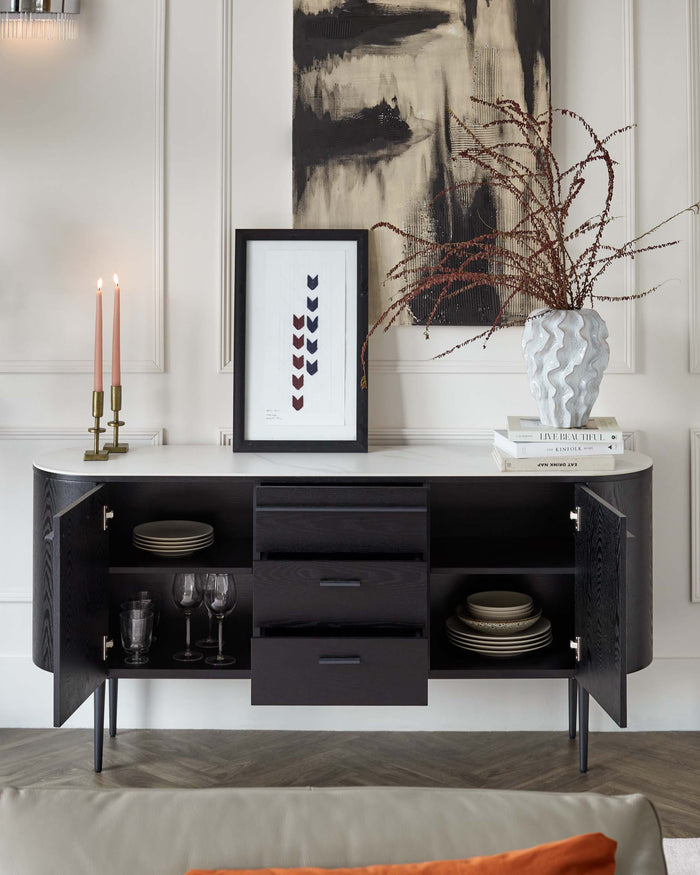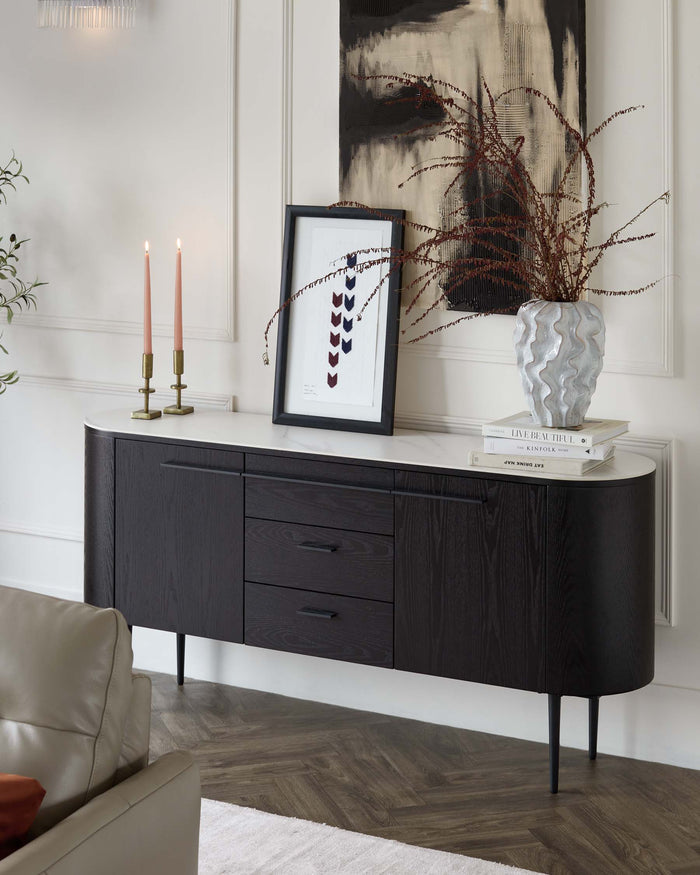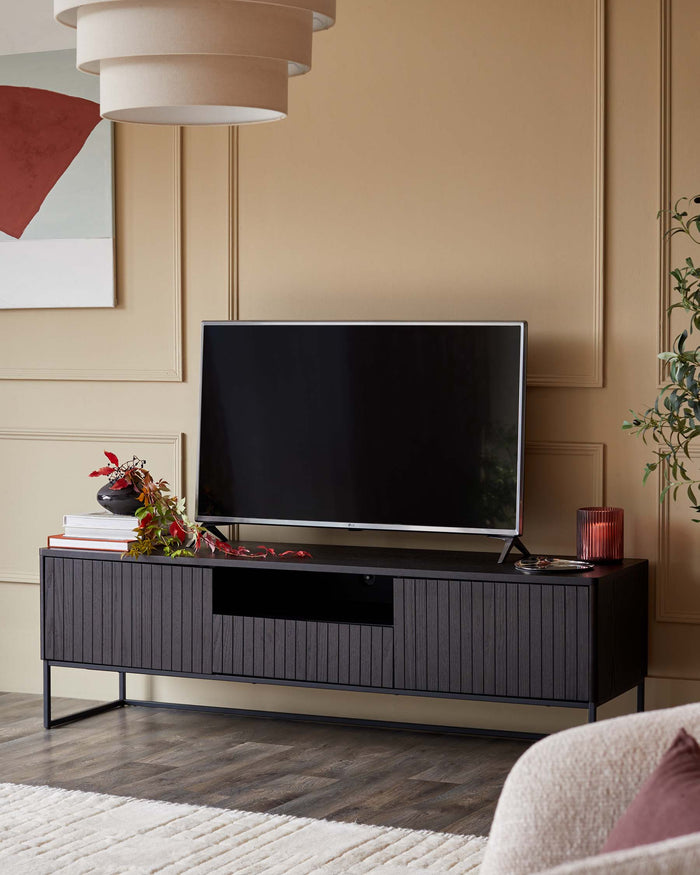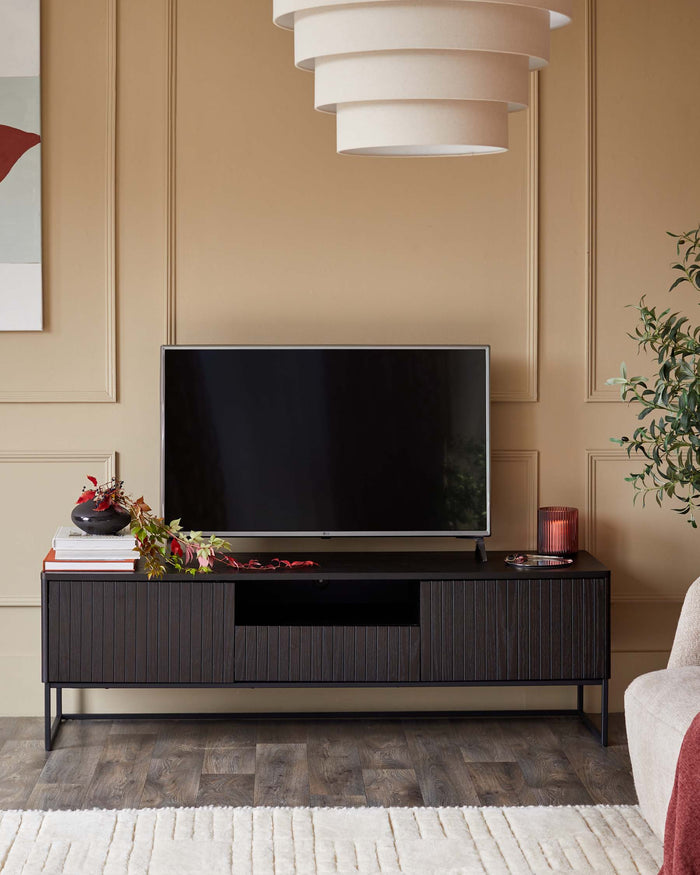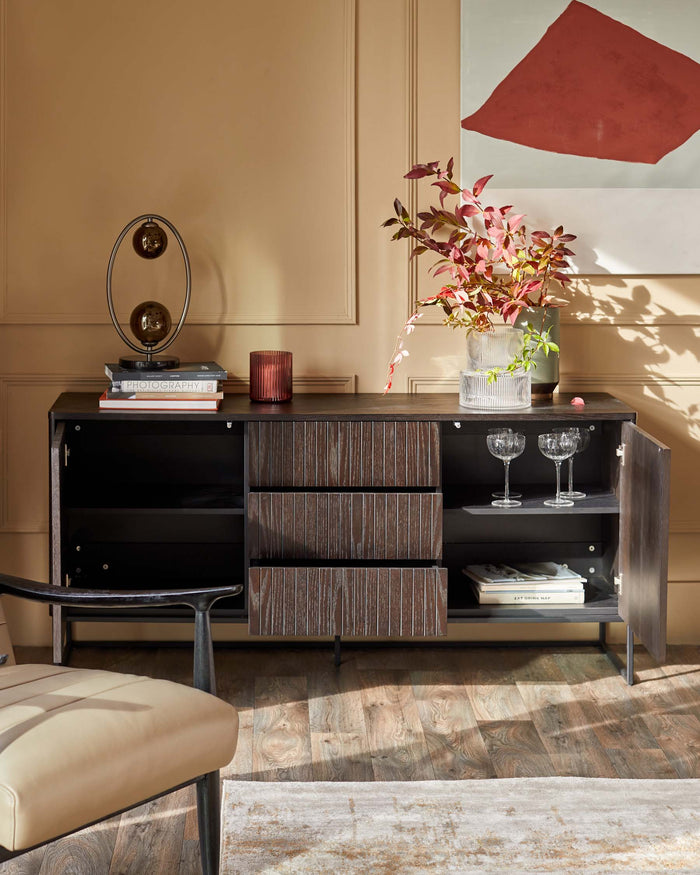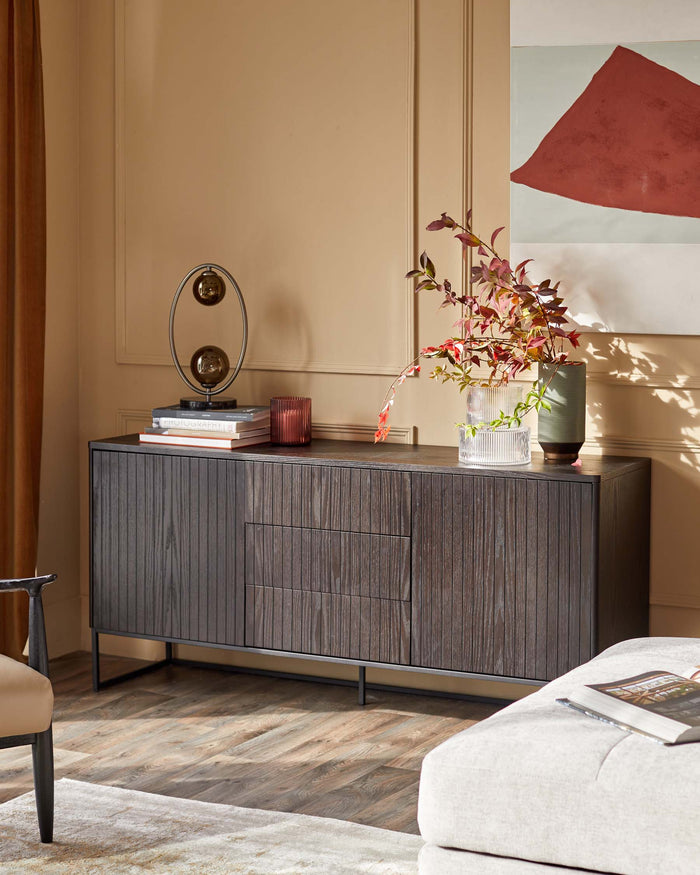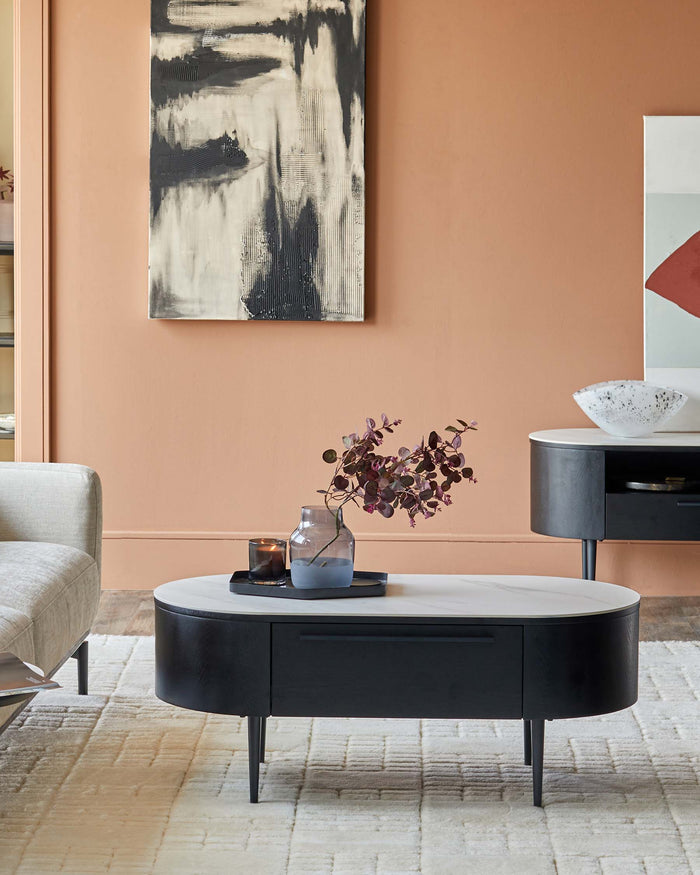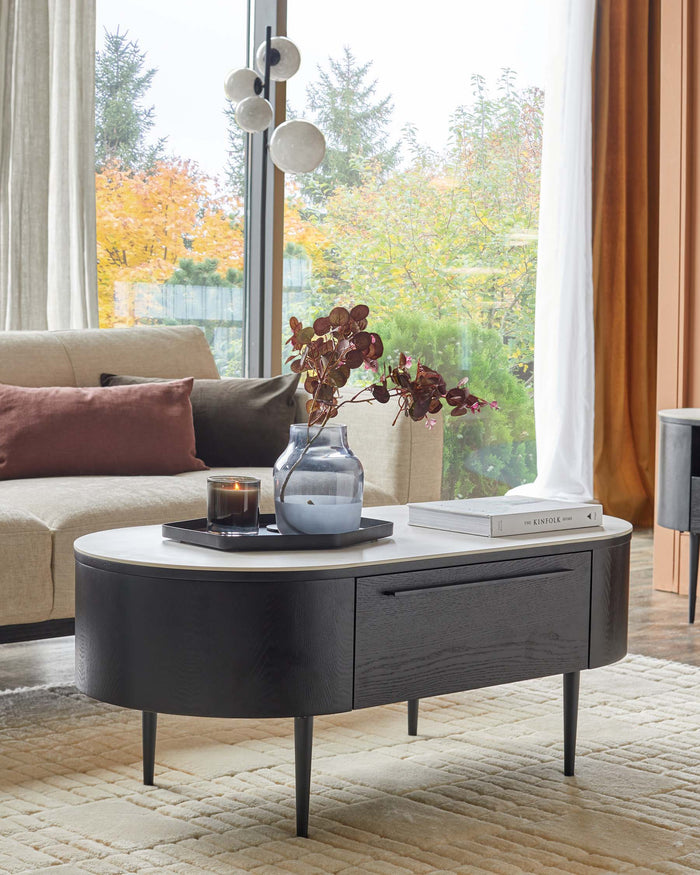If you hear the term wood veneer and instantly think of cheap, thin, flat-pack furniture, it’s time you thought again! Wood veneers are an excellent material choice for many furniture pieces due to their clean look and the variety of colours and styles available. In this post, we’ll talk you through the different types of wood veneer, which to go for to create a certain look, and how to care for this material in your home.
So, What is a Wood Veneer?
A wood veneer is typically made up of a thin layer of natural hardwood, that is then bonded to a stable composite base material. The purpose of a veneer is that it’s more affordable than solid timber as less actual wood is used, but also, the base material gives the whole thing overall stability. Natural, solid wood is very susceptible to moisture, meaning it can result in warping if left. Veneers ensure that furniture not only looks great but is also long-lasting.
Wood Veneer vs. Solid Wood Furniture
If you’re stuck between choosing real wood furniture and furniture with a wood veneer finish, there are more factors to consider than just the price. Here we’ve broken down some pros and cons of each material. It’s important to consider which factors would benefit you most when shopping for your new furniture.
Advantages of Solid Wood
Solid wood furniture is very durable and, in many cases, easy to repair. This includes anything from scratches, watermarks, dents and stains. You can usually give it a light sand with fine sandpaper to take care of any markings.
Disadvantages of Solid Wood
Because real wood furniture is, well, real wood, it can be prone to splitting. This generally only happens in extreme conditions, but real wood furniture can expand and contract causing it to split along the grain. To prevent splitting, try to avoid exposing solid wood furniture to strong sunlight or direct heat sources. Waxes and oils can help prolong the life of real wood furniture but takes more maintenance. Solid timber is susceptible to changes in atmospheric conditions. Fluctuations in temperature can mean that surfaces warp and bend.

Advantages of Wood Veneer Furniture
Wood veneer is actually far better for the environment. As it’s solid wood sliced into multiple pieces, it means much more can be made out of one piece of wood. Meaning less trees, which is always a good thing. There are also lots of design possibilities for wood veneer furniture. Since veneer is far thinner than solid wood, it allows designs and arrangements of the wood that solid wood just couldn’t achieve. Good quality wood veneer furniture is also very stable. This is because the veneer is glued to a stable substrate, so the surface isn’t prone to warping or splitting.
Disadvantages of Wood Veneer Furniture
Wood veneer can blister, delaminate or peel back at the edges if not treated with care. However, this is incredibly easy to prevent by using mats each mealtime and by giving your wood veneer furniture a regular, light clean.
Wood Veneer Finishes: Oak, Walnut and Painted Oak

Like with solid wood, there are a whole variety of wood veneer finishes available, each with their own features and benefits. Here are our top 3 wood veneer picks, each with the look that they’ll help to create in your home:
Walnut Veneer
If you’re looking to create a warm, rich and tactile look, opt for walnut veneer furniture. Style alongside Black Chrome Dining Chairs for a really visually strong, dark luxe look. Alternatively, try styling your walnut veneer alongside glass furniture to help lift and lighten your space.
Oak Veneer
Furniture with an oak wood veneer has a lighter look, with a slightly modern Scandinavian feel. This creates an ideal opportunity to style it alongside some slightly more modern finishes, such as gloss or brushed metal. An oak veneer dining table or set of side tables are a great way to add a hint of wooden texture to your room, while keeping your space looking bright and fresh.
White Oak or Painted Veneer
If you’re looking for a really crisp and contemporary finish, take a look at a white oak veneer. Just like a gloss finish, a white oak veneer allows you to create a really fresh and modern look. But unlike gloss, a white oak or painted veneer isn’t shiny or reflective. Instead, you get a subtle but lovely wood grain running throughout the surface. With a painted wood veneer finish you really do get the best of both worlds- a super fresh and modern look with the tactile qualities of a wooden finish.
How To Clean A Wood Veneer: The Do’s and Don’ts
Aim to dust your wood veneer regularly with a dry, soft cloth to help keep it looking its best. Then for a quick, non-deep clean, you can spray a wood veneer with a light layer of non-ammonia glass cleaner and wipe it with a paper towel.
When cleaning, avoid using any furniture polishes that contain wax or silicone. If used, wax can build up on your veneer furniture and over time, lead to a cloudy and uneven appearance. Silicon meanwhile leaves behind an unsightly white residue that destroys the furniture finish.
So be sure to check what’s in the cleaning product you are using, just to be safe. This goes without saying, but never use any kind of abrasive cleanser or cloth on a wood veneer. Stick to soft cleaning agents and clean cloths as to not damage the surface.
Maintenance of Your Wood Veneer
If any minor marks appear on your veneer furniture, have no fear! In many cases, this can be treated with a few DIY furniture restoration tricks. Before you start, be sure to clean your veneer with a mild soap and some water to remove any dirt, wax or silicone deposits.
For marks and small scratches, try applying a high-quality furniture polish to hide small scratches in the wood furniture finish. To do this, rub the polish in with a soft cloth until the scratch is no longer visible.
For deeper scratches or gouges, there are a variety of furniture repair kits that will help to fill and colour any nicks or gouges. Just be sure to read the manufacturer’s instructions first, and test a small patch, just to be sure!
How to Care For Your Wood Veneer
When it comes to protecting your wooden veneers, there are three main things you’ll need to keep an eye on (and try to avoid!) These are sunlight, heat and moisture.
How to Avoid: Sun Damage
If exposed to direct sunlight over long periods of time, the colour of your wood veneer furniture can be subject to fading. This is incredibly easy to prevent by not placing your wooden furniture in front of windows or in direct sunlight. If that is not an option due to the design or layout of your room, you can always protect your veneer with blinds, curtains or UV screens and films.
How to Avoid: Moisture Damage
If you spill any liquid on your wood veneer dining table, try to wipe this up as soon as possible. If left, liquids can seep through the veneer and loosen the glue from the surface. Don’t use a sponge as this can just spread the liquid. Instead, use a paper towel or a clean dishcloth. It’s best to use coasters under glasses to avoid water rings from drinks. It may seem minor, but water rings can cause damage to veneer tables by soaking the finish and changing its opacity. Avoid any damage by using mats and coasters each meal time.
How to Avoid: Heat Damage
It’s important to protect your wood veneer table top as the heat or steam from very hot plates can, over time, loosen the glue holding the veneer to the surface underneath. This is really easy to avoid by using placemats and coasters each meal time. Avoid placing plates and dishes straight from the oven onto a wooden veneer table surface as this will damage the surface. A heatproof mat will do just the trick and help protect the surface.
Top Tip: Placing trivets under hot serving bowls will prevent high heat causing the veneer to blister. Check your trivets have felt bottoms as this will further protect the veneer from both the heat and scratches.
So, have we managed to change your opinion on wood veneer furniture? After seeing so many stylish wood veneer pieces and how versatile this material can be, we hope we’ve inspired you to introduce this finish to your home. To see our full range of wood veneer products, from Dining Tables and Sideboards, to Consoles and Side Tables, be sure to check out our collection pages.


